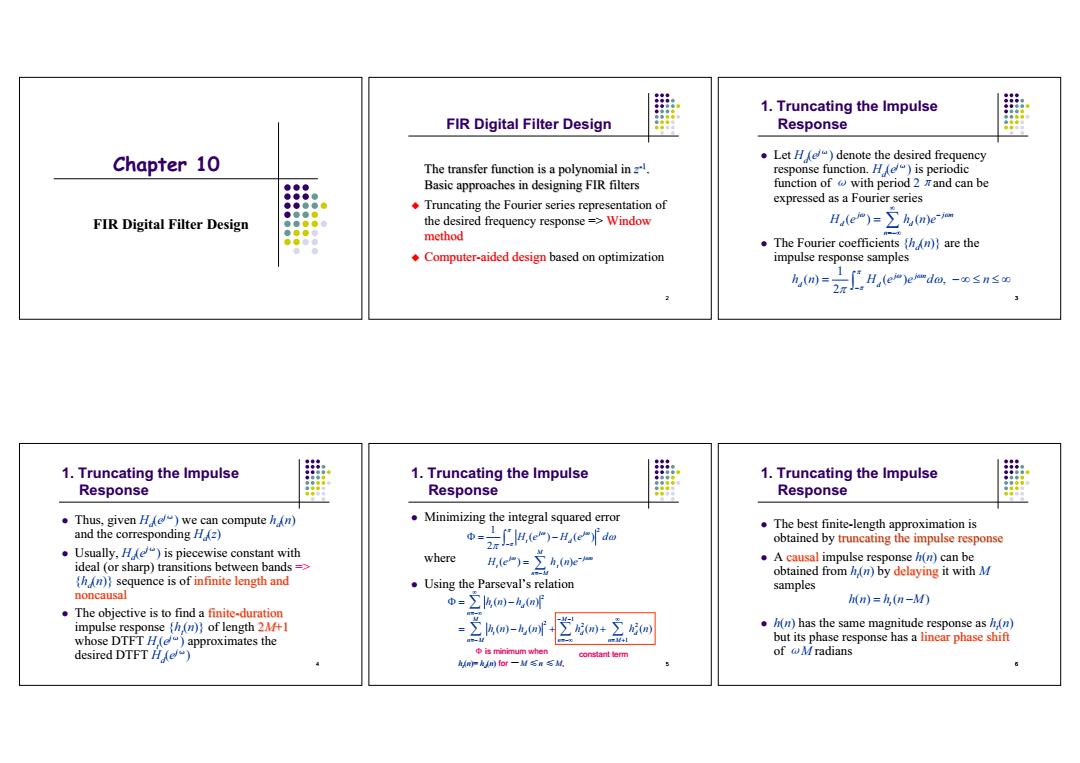正在加载图片...

1.Truncating the Impulse FIR Digital Filter Design Response Chapter 10 Let H")denote the desired frequency The transfer function is a polynomial in response function.H")is periodic ●●● Basic approaches in designing FIR filters function of with period 2 and can be Truncating the Fourier series representation of expressed as a Fourier series FIR Digital Filter Design the desired frequency response=>Window H.(e)=h(n)e method The Fourier coefficients (hAn))are the Computer-aided design based on optimization impulse response samples m=云上心-a-snsa 1.Truncating the Impulse 1.Truncating the Impulse 1.Truncating the Impulse Response Response Response Thus,given H)we can compute h (n) Minimizing the integral squared error The best finite-length approximation is and the corresponding A(z) -2-fa obtained by truncating the impulse response .Usually,He")is piecewise constant with where -三e .A causal impulse response /(n)can be ideal(or sharp)transitions between bands=> (hAn))sequence is of infinite length and obtained from h(n)by delaying it with M .Using the Parseval's relation samples noncausal 中=∑k(m)-h,f (n)=h,(n-M) The objective is to find a finite-duration impulse response (h,(n)of length 2M+I c)-wco 芝m+2m .h(n)has the same magnitude response as h(n) whose DTFTH,()approximates the M+l but its phase response has a linear phase shift desired DTFT H) 中is minimum when con时ant term of @Mradians PU间r一Mm≤就Chapter 10 FIR Digital Filter Design 2 FIR Digital Filter Design The transfer function is a polynomial in The transfer function is a polynomial in z-1. Basic approaches in designing FIR filters Basic approaches in designing FIR filters Truncating the Fourier series representation of the desired frequency response => Window method Computer Computer-aided design based on optimization 3 1. Truncating the Impulse Response Let Hd(ej¹) denote the desired frequency response function. Hd(ej¹) is periodic function of ¹ with period 2±and can be expressed as a Fourier series The Fourier coefficients {hd(n)} are the impulse response samples ( ) () j jn d d n H e h ne 1 () ( ) , 2 j jn d d hn He e d n 4 1. Truncating the Impulse Response Thus, given Hd(ej¹) we can compute hd(n) and the corresponding Hd(z) Usually, Hd(ej¹) is piecewise constant with ideal (or sharp) transitions between bands => {hd(n)} sequence is of infinite length and infinite length and noncausal noncausal The objective is to find a finite-duration impulse response {ht(n)} of length 2M+1 whose DTFT Ht(ej¹) approximates the desired DTFT Hd(ej¹) 5 1. Truncating the Impulse Response Minimizing the integral squared error where Using the Parseval’s relation 1 2 () () 2 j j Ht d e He d ( ) () M j jn t t n M H e h ne 2 1 2 2 2 1 () () () () () () t d n M M td d d n M n nM hn h n hn h n h n h n
is minimum when constant term ht(n)= hd(n) for ˉM İ n İ M, 6 1. Truncating the Impulse Response The best finite-length approximation is obtained by truncating the impulse response truncating the impulse response A causal impulse response h(n) can be obtained from ht(n) by delaying it with M samples h(n) has the same magnitude response as ht(n) but its phase response has a linear phase shift linear phase shift of ¹M radians () ( ) t hn h n M ������������������������������